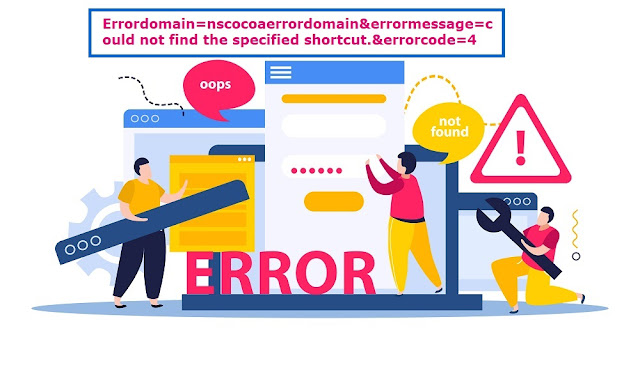In the dynamic world of technology, encountering errors is not uncommon, and each error code holds clues to unraveling the underlying issue. One such error that users may come across is associated with the NSCocoaErrorDomain, and it manifests as an error message that reads, "Could not find the specified shortcut," accompanied by an error code 4. Let's delve into the intricacies of this error, understand its implications, and explore potential solutions.
Decoding NSCocoaErrorDomain:
The
NSCocoaErrorDomain is part of the Cocoa error handling framework used in
Apple's programming environments, including macOS, iOS, watchOS, and tvOS. It
encompasses a range of error codes that developers and users may encounter when
interacting with Apple's frameworks and APIs.
Error Message: "Could Not Find the Specified Shortcut:"
The
error message, "Could not find the specified shortcut," indicates
that the system or application is unable to locate a particular shortcut
referenced or requested. Shortcuts, in this context, typically refer to
user-defined or system-assigned shortcuts that facilitate quick access to
specific actions or functionalities within an application or the operating
system.
Error Code 4: Unraveling the Significance:
Error code 4, in the NSCocoaErrorDomain, is a numerical identifier assigned to this particular error scenario. Each error code carries unique information, aiding developers and users in diagnosing the issue. In the case of "Could not find the specified shortcut," error code 4 suggests that the system or application failed to locate the designated shortcut, potentially disrupting the intended user experience.
Possible Causes of the Error:
Causes of Errordomain=NSCocoaErrorDomain&ErrorMessage=Could Not Find the Specified Shortcut.&ErrorCode=4
Encountering
an error with the message
"Errordomain=NSCocoaErrorDomain&ErrorMessage=Could Not Find the
Specified Shortcut.&ErrorCode=4" signifies a challenge in the realm of
shortcut handling within the Apple ecosystem. Delving deeper into the potential
causes of this error is crucial for users and developers seeking to resolve the
issue and restore smooth functionality. Let's explore the intricacies behind
this error code and understand the underlying factors contributing to its
occurrence.
1. Corrupted or Missing Shortcut Data:
A
prevalent cause of this error is the presence of corrupted or missing data
associated with the specified shortcut. The system relies on accurate and
intact information to locate and execute shortcuts. If the data becomes
corrupted or is inadvertently deleted, the system may struggle to find the
designated shortcut, triggering the error.
2. Changes in System Configuration:
Modifications
to the system configuration, whether intentional or resulting from updates, can
disrupt the referencing of shortcuts. An alteration in the way shortcuts are
stored or referenced within the system can lead to the error message. This may
occur after an operating system update or changes in application settings.
3. Application-Specific Issues:
The
error might be specific to the application or service where the shortcut is
intended for use. Application-specific issues, such as bugs or conflicts within
the software, can impede the proper identification and execution of shortcuts.
Troubleshooting within the context of the specific application may be necessary
to pinpoint and resolve these issues.
4. System or Software Update Impact:
System
updates or updates to relevant software applications could potentially impact
the compatibility or functionality of existing shortcuts. The error may arise
if the updated version introduces changes that affect the way shortcuts are
handled or referenced by the system.
5. User Configuration Errors:
Errors
can also occur due to misconfigurations made by users. Incorrectly assigning or
configuring shortcuts within the system or applications can result in the
failure to locate the specified shortcut, leading to the generation of the
error.
6. File System Issues:
Issues
within the file system, such as file corruption or misplacement of
shortcut-related files, can contribute to the error. A well-functioning file
system is crucial for the seamless execution of shortcuts, and any anomalies in
this aspect can lead to errors.
7. Environmental Changes:
Environmental
changes, such as alterations in the device's settings or the introduction of
new hardware, may impact the system's ability to locate shortcuts. Ensuring
that the environment remains consistent with the expectations of the shortcut
configuration is essential for error prevention.
8. Security Software Interference:
In
some cases, security software or antivirus programs may interfere with the
proper functioning of shortcuts. These programs may flag or block certain
actions associated with shortcuts, leading to the error message.
Troubleshooting and Solutions:
Navigating Solutions Errordomain=NSCocoaErrorDomain&ErrorMessage=Could Not Find the Specified Shortcut.&ErrorCode=4
Encountering
an error, especially one like
"Errordomain=NSCocoaErrorDomain&ErrorMessage=Could Not Find the
Specified Shortcut.&ErrorCode=4," can be a source of frustration for
users navigating the intricacies of the Apple ecosystem. However, a systematic
approach to resolving this error is within reach. Let's explore a variety of
potential solutions to address this specific error code and restore the
seamless functionality of shortcuts.
1. Verify Shortcut Configuration:
Begin
the troubleshooting process by verifying the configuration of the specified
shortcut. Ensure that the shortcut is correctly defined with accurate details
and associated actions. This includes checking any linked data or functionality
to confirm its integrity.
2. Recreate the Shortcut:
Consider
recreating the problematic shortcut from scratch. Delete the existing shortcut
and set it up again, following the proper steps and ensuring that all
configurations are accurate. This helps eliminate any potential issues related
to the previous configuration.
3. Check Recent Changes:
Review
recent changes to the system or application that might have contributed to the
error. If the issue coincides with a system update or changes in application
settings, consider reverting to a previous configuration or adjusting settings
to align with the latest software version.
4. Investigate Application-Specific Issues:
If
the error is specific to a particular application or service, consult the
documentation or support resources for that application. Application-specific
troubleshooting steps may provide insights or solutions tailored to the unique
functionalities of the software.
5. Examine File System Health:
Ensure
the health of the file system by checking for any signs of corruption or
misplacement of files related to shortcuts. Running file system checks or disk
utility tools can help identify and resolve issues within the file structure.
6. Reevaluate User Configuration:
Double-check
user-configured settings related to shortcuts. Verify that shortcuts are
assigned correctly and that there are no conflicting configurations. User
errors in assigning or configuring shortcuts can be a common cause of this type
of error.
7. Review Environmental Changes:
If
there have been recent environmental changes, such as adjustments to device
settings or the introduction of new hardware, evaluate their impact on shortcut
functionality. Ensuring consistency with expected configurations is vital for
error prevention.
8. Disable Security Software Temporarily:
Temporarily
disable security software or antivirus programs and check if the error
persists. Security software can sometimes interfere with shortcut actions. If
disabling the software resolves the issue, consider adjusting its settings to
allow for the proper functioning of shortcuts.
9. Seek Developer or Community Support:
If
the error persists and is related to a specific application, reaching out to
the developer's support or seeking assistance from community forums can provide
valuable insights. Developers or experienced users may have encountered similar
issues and can offer guidance on potential solutions.
10. Update Software:
Ensure
that both the operating system and relevant applications are up to date.
Updates often include bug fixes and improvements that can address compatibility
issues and enhance overall system stability.
Conclusion:
Encountering
errors like "Could not find the specified shortcut" with error code 4
in the NSCocoaErrorDomain can be perplexing, but understanding the context and
potential causes empowers users and developers to address the issue
effectively. As technology evolves, error handling becomes integral to
providing seamless user experiences, and deciphering error messages becomes a
valuable skill in navigating the intricacies of software and system interactions.
FAQ’s:
Frequently
Asked Questions (FAQs) on NSCocoaErrorDomain Error with Code 4: "Could Not
Find the Specified Shortcut"
Q1: What does the error
message "Errordomain=NSCocoaErrorDomain&ErrorMessage=Could Not Find
the Specified Shortcut.&ErrorCode=4" mean?
A1:
This error indicates a failure to locate a specified shortcut within the Apple
ecosystem. The NSCocoaErrorDomain, associated with Cocoa programming, reports
that the system or application encountered difficulties finding the designated
shortcut, with the error code 4 providing additional context.
Q2: What could be
causing this error?
A2:
Several factors may contribute, including corrupted or missing shortcut data,
changes in system configuration, application-specific issues, impact from
recent updates, user configuration errors, file system issues, environmental
changes, and potential interference from security software.
Q3: How can I resolve
this error?
A3:
Start by verifying the shortcut configuration, recreating the shortcut if
necessary, and checking for recent changes or updates. Investigate
application-specific issues, examine file system health, reevaluate user
configurations, review environmental changes, and temporarily disable security
software. Seeking assistance from developer support or community forums and
ensuring software is up to date are also recommended.
Q4: Should I be
concerned about the error code 4 in NSCocoaErrorDomain?
A4:
While error codes indicate issues, they are part of the system's error handling
mechanism. Code 4 suggests a failure to find the specified shortcut, but
addressing the root cause through troubleshooting steps can often resolve the
issue without significant concerns.
Q5: Can recreating the
shortcut solve the problem?
A5:
Yes, recreating the shortcut is a recommended troubleshooting step. Deleting
the existing shortcut and setting it up again ensures a fresh and accurate
configuration, addressing potential issues associated with the previous setup.
Q6: How can I check for
recent changes that might have caused the error?
A6:
Review recent system updates, changes in application settings, or modifications
to configurations that may coincide with the appearance of the error. Reverting
to a previous configuration or adjusting settings to align with the latest
software version may resolve the issue.
Q7: What should I do if
the error persists after troubleshooting?
A7:
If the error persists, consider seeking assistance from the developer's support
for the specific application generating the error. Community forums can also
provide insights from users who may have encountered and resolved similar
issues. Additionally, ensure that both the operating system and relevant
applications are up to date.
Q8: Can security
software interfere with shortcut functionality?
A8:
Yes, security software or antivirus programs may interfere with shortcut
actions. Temporarily disabling such software and checking if the error persists
can help identify whether security software is contributing to the issue.
Adjusting security software settings may be necessary for proper shortcut
functionality.
Q9: How important is it
to keep software up to date?
A9:
Keeping both the operating system and relevant applications up to date is
crucial. Updates often include bug fixes, improvements, and enhanced compatibility,
addressing issues that may lead to errors like the one associated with
NSCocoaErrorDomain and Code 4.
Q10: Can this error
impact other functionalities on my device?
A10:
While the error is specific to the failure to find a specified shortcut,
addressing it promptly is advisable to maintain a smooth user experience.
However, its impact is generally localized to the functionality associated with
the affected shortcut.









.jpg)
.jpg)

0 Comments